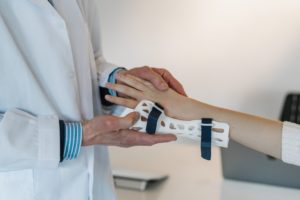Accessibility, sometimes written in short form as a11y, is often the lowest item on a website priority list, if it even makes it on the list at all. As I’ve been learning about developing and maintaining accessible websites, I’ve noticed that many people still have a lot of apprehension around ensuring their sites are accessible. They simply fail to understand that accessible websites benefit everyone. There are many reasons why people don’t bother making their site accessible. This post will address one in particular that I hear quite frequently: The people who visit my site don’t have disabilities.
Think about that for a minute. How do you know that? Whether or not your visitors have a disability is not a metric tracked by your favourite analytic software. I guarantee you the opposite is true. Your website absolutely does have visitors who have disabilities.
How can I be so sure? The answer is simpler than you might think: we have all experienced some form of disability, and we will again.
What’s a Disability?
 Often the image of a person with a disability is someone who is blind or deaf. These are permanent disabilities. However, there are also temporary and situational disabilities that exist, too.
Often the image of a person with a disability is someone who is blind or deaf. These are permanent disabilities. However, there are also temporary and situational disabilities that exist, too.
To put these into context, consider your dominant arm. If it were amputated, that would be a permanent disability. If it were broken, that would be a temporary disability. If you were holding a bag of groceries, that might be a situational disability. All of these scenarios would prevent you from using that arm for a period of time. So you can imagine how having a mobile version of your website that is easy to navigate with only one hand would benefit more than just people who only have one hand.
There are lots of other examples of temporary and situational, as well as permanent, disabilities that people experience which impact how they use a website. Improving the accessibility of your website will ensure all your visitors have the best experience possible. Let’s look at how an accessible website benefits everyone and what the potential barriers to a successful site visit might be, as well as some conditions that might be affected.
Neurological Scenario
Imagine: You get home from work and have to feed your kids. You have a migraine. The kids are excited and loud, adding to the brain fog from your migraine. You decide to order delivery from a website.
Potential Barriers
 As you visit the restaurant’s website, you want to place your order and pay as easily and quickly as possible. Navigation, buttons and links should be easy to find and their purpose should make sense, otherwise you could get confused and frustrated. Too many calls-to-action fighting for your attention are distracting at the best of times, but when you can barely concentrate on the task at hand, they can also cause confusion.
As you visit the restaurant’s website, you want to place your order and pay as easily and quickly as possible. Navigation, buttons and links should be easy to find and their purpose should make sense, otherwise you could get confused and frustrated. Too many calls-to-action fighting for your attention are distracting at the best of times, but when you can barely concentrate on the task at hand, they can also cause confusion.
Fast-moving animations can make your headache worse and might even make it hard for you to look at the screen. And if you make it to the checkout page, there are a variety of form issues that can make it hard to complete your order, like disappearing placeholder text or not being able to click into a particular field. Encountering any of these issues could result in you giving up and taking your business elsewhere.
Migraines fall under the neurological category of accessibility, which includes ADHD, epilepsy, and autism as permanent disabilities. Other disabilities and related situations include:
- Brain fog
- Lack of sleep
- Flu/cold
- Anxiety
- Depression
- Stress
- Distracting environment
Audio Scenario
Imagine: You decide to remote work from the local coffee shop. Stuck on a problem, you search for a tutorial and find the perfect video embedded on its own webpage. But darn it… you forgot your headphones at home!
Potential Barriers
 Without your headphones, you won’t really be able to hear the sound on the video without disturbing everyone in the shop. If there are no subtitles or closed captioning, you can’t put the video on mute and follow along. If the person didn’t include a transcript, summary, or other written form of the content, and your only way to get the information is to watch the video, you are out of luck.
Without your headphones, you won’t really be able to hear the sound on the video without disturbing everyone in the shop. If there are no subtitles or closed captioning, you can’t put the video on mute and follow along. If the person didn’t include a transcript, summary, or other written form of the content, and your only way to get the information is to watch the video, you are out of luck.
Another issue that isn’t a barrier, but can cause issues, is when videos (and audios) are set to autoplay. I can’t tell you the number of times I’ve jumped out of my seat being startled by autoplaying videos, even on sites that I visit every week! These situations all fall under the audio category of website accessibility, which includes people who have some form of permanent hearing loss. Other disabilities and related situations include:
- Tinnitus
- Plugged ear
- Skimming text to find a quick answer
- Learning a new language
- Loud environments
Keyboard Scenario
You are a WordPress developer who never takes your hands off the keyboard. There is not a mouse to be found anywhere in your office and you know all the keyboard shortcuts. You decide to register in an online course for the latest and greatest headless platform.
Potential Barriers
 As you start tabbing through the page, there are several potential frustrations you might encounter. If there is no “Skip to Content” option, you’ll have to tab through every menu item in the main navigation. And speaking of that navigation, hopefully it’s set up correctly so you can easily avoid all of the sub-menu items, otherwise you’ll start to wonder if you’ll ever get out of the header area.
As you start tabbing through the page, there are several potential frustrations you might encounter. If there is no “Skip to Content” option, you’ll have to tab through every menu item in the main navigation. And speaking of that navigation, hopefully it’s set up correctly so you can easily avoid all of the sub-menu items, otherwise you’ll start to wonder if you’ll ever get out of the header area.
Some sites have removed any focus indications on links and buttons, so you’ll have no idea t where you have tabbed. Others have implemented a tab flow that doesn’t seem to have any rhyme or reason to it, taking you from the top of the page to a form at the bottom of the page, then to the middle left and maybe over to the top left then down to the middle right… are you confused yet? Me, too.
By the time you get through to the registration form, you might get stuck in “keyboard traps,” like not being able to return to a field once you’ve move on to the next one, or being unable to leave the form any way other than hitting the submit button. These frustrations are in the physical category of website accessibility; and in this case, specifically those who require a keyboard or other button-based device to navigate the web. Other disabilities and related situations include:
- Broken arm/wrist/finger
- Carpal Tunnel Syndrome
- Mouse battery died
- Sleeping baby or pet on your lap (they’re too cute to move!)
Visual Scenario
You live in California and work online from home. It’s a hot summer day and you don’t have an air conditioner, so your windows are open. Wildfires break out nearby, causing poor air quality that irritates your eyes and blurs your vision. Utilities are affected and your wifi signal has become weaker than normal.
Potential Barriers
 Your poor eyes are having a hard enough time staring at the screen all day. Visit a website with small text, in a thin condensed font, and you’ll feel like you’re trying to read the last row on an eye exam chart. Sure, you can try to zoom in and make the text bigger, but there’s the possibility the layout isn’t well-suited to resizing either.
Your poor eyes are having a hard enough time staring at the screen all day. Visit a website with small text, in a thin condensed font, and you’ll feel like you’re trying to read the last row on an eye exam chart. Sure, you can try to zoom in and make the text bigger, but there’s the possibility the layout isn’t well-suited to resizing either.
If there isn’t enough contrast between the color of the font and the background, maybe it’s a light grey on off-white, and it might seem like you are looking at a blank page. What if the only difference between linked text and regular text is navy blue instead of black? There is a good chance you won’t realize that you can click on that navy blue text. Remember that weak wifi signal? It could prevent images from loading, and if there isn’t appropriate alt text set up, you could be missing important information.
These scenarios all fall into the visual category of website accessibility, affecting people who have colour blindness or reduced vision. Other disabilities and related situations include:
- Eye injury
- Dilated eyes from eye exam
- Aural migraine
- Bright sun shining in eyes or on screen
- Allergies
- Forgotten reading glasses
Normalize Accessible Websites
All of the scenarios were based on real examples, many that I have personally experienced. Maybe you can relate to many of them, too. If not, I’m sure you have experienced some of the other disabilities and related situations listed at the end of each scenario. I challenge you to come up with your own examples, which you can share with others, helping make website accessibility considerations become more commonplace. At the very least, I hope I have convinced you that owning, maintaining, and making an accessible website benefits everyone.
Comments